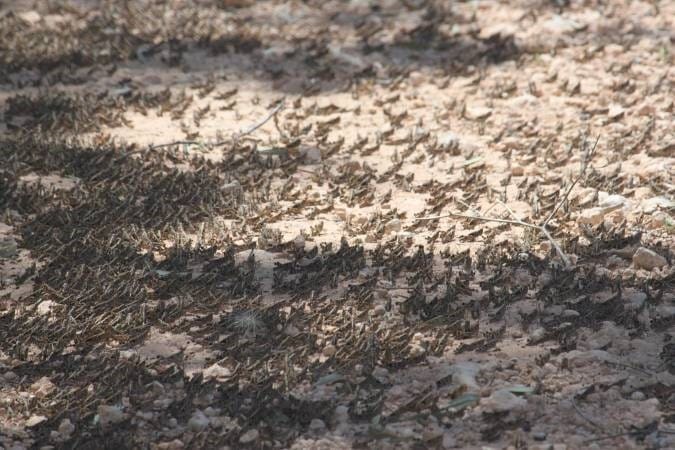
Locust hoppers marching. Image – Agriculture Victoria.
LOCUSTS seen in multiple locations across northern Victoria have prompted a call for the community to report sightings.
Locust sightings are expected at this time of the year and bands of hoppers have been reported throughout the Loddon, Greater Bendigo, Campaspe and Moira shires.
Agriculture Victoria Victorian Plague Locust Commissioner Dr Kyla Finlay said these are localised populations and not considered a plague, nor is a plague expected this season.
“We encourage the community to report locust sightings to us online via our website or via 136 186 – this helps us track and share information about locust movements throughout the state.”
Agriculture Victoria said controlling hoppers now will reduce the numbers coming into Autumn and the banding stage provides land managers with the ideal opportunity to undertake management options as they are relatively slow and provide a clear target. Fledging adults are already being seen in the Loddon Shire.
If left uncontrolled, the majority of hoppers will reach adulthood and take flight – moving in search of green feed and laying eggs which will overwinter to hatch in Spring, Agriculture Victoria said.
Based on surveillance and modelling data, the Australian Plague Locust Commission is predicting a moderate population increase to medium density population levels in inland eastern Australia with localised areas of medium to high densities in New South Wale’s Riverina area and Victoria’s north-west and north central regions.
Landholders are responsible for reporting and managing locusts on their land. Agriculture Victoria continues to undertake surveillance, and liaise with the Australian Plague Locust Commission, to help landholders make decisions about locust management activities.
Ground control using a chemical insecticide is the most successful method to manage locusts. The most effective time to spray locusts is at the second or third instar stage (around two weeks after hatching), when hoppers are wingless and band densities reach or exceed 80 hoppers per square metre. At this stage, hoppers form large, slow-moving bands, providing a clear target for efficient and effective insecticide use. Programs to treat adult flying locusts are generally ineffective.
Agriculture Victoria has a range of resources for landholders to learn more about Australian plague locusts, including situation updates, a map of current sightings, as well as biology and management options via https://agriculture.vic.gov.au/locusts.
Australian plague locusts (Chortoicetes terminifera) are native insects that, if left unmanaged, can pose a serious threat to pastures, crops and horticulture.
Currently registered and or permitted insecticides to manage locusts fall into 4 broad categories: Carbamates (Group 1A), Organophospates (Group IB), Phenylpyrazoles (Group 2B, Synthetic pyrethroid insecticides (Group 3A); each with their own active ingredients. To determine the appropriate chemical for your situation, consult with your local agronomist and check the Australian Pesticide and Veterinary Medicine Authority (APVMA) website which provides advice.
Further information will be shared regularly by Agriculture Victoria as the season progresses. All Victorians are encouraged to report sightings of locusts to Agriculture Victoria using the online reporting form.
For more information about Australian plague locusts, see Australian plague locust – biology and behaviour. A twenty minute interactive short learning course is also available online – Australian plague locust online learning module

HAVE YOUR SAY